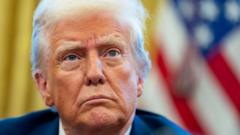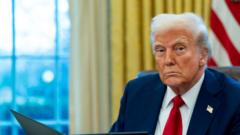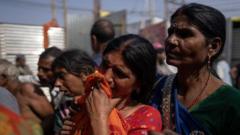With a GDP drop to 5.4% amidst rising inflation and stagnant wages, India's economic growth narrative faces scrutiny.
Economic Slowdown: Is India's Growth Story Facing a Setback?

Economic Slowdown: Is India's Growth Story Facing a Setback?
India records its lowest GDP growth in two years as various factors impact consumer demand and investment.
India's economy, once hailed as the fastest-growing among major nations, has recently shown signs of distress as the GDP slid to 5.4% for the July-September quarter, marking a seven-quarter low. This figure falls below the Reserve Bank of India's (RBI) expected growth of 7%, igniting concerns among economists and policymakers alike. While still comparing favorably to developed nations, the downturn raises questions about the sustainability of India's economic momentum.
Analysts suggest a confluence of factors at play. Weak consumer demand, a prolonged period of sluggish private investment, and a pullback in government spending — historically a key growth driver — are among the culprits. Additionally, India's goods exports have faced challenges, accounting for a mere 2% of global trade shares in 2023.
Although the Finance Minister, Nirmala Sitharaman, projects optimism, claiming that the decline is "not systemic" and rather developmental, others like economist Rajeshwari Sengupta suggest a tougher reality. "There's a clear slowdown and a serious demand problem," she remarked, expressing concern over the troubling shift in economic dynamics.
Compounding these issues, inflation surged to 6.2% in October, primarily spurred by soaring vegetable prices. Despite the RBI's effort to control inflation for nearly two years by maintaining high-interest rates, there are fears that such policies may hinder growth. The costs of borrowing have risen, making it more challenging for businesses and consumers alike to invest or spend.
Interestingly, urban consumption is waning while rural demand exhibits resilience due to a favorable monsoon season and improved agricultural circumstances. However, the informal "old economy" continues to languish, unable to catch up with the newer sectors that have boomed post-Covid, especially in the technology and service industries.
Deloitte data indicates that over 50% of the world's Global Capability Centres are now based in India, which has fueled urban spending on luxury goods and real estate. Yet, as these centres mature, the demand boost they provided appears to be receding, exposing a pressing need for innovation and investment in the traditional sectors.
Further complicating matters, average tariffs have increased significantly, now surpassing those of key Asian competitors, making Indian goods less competitive globally. Critically, the RBI's recent initiatives to bolster the weakening rupee by using forex reserves have tightened market liquidity, creating a paradox of supporting currency strength while stifling trade competitiveness.
Critics argue that the narrative surrounding India's status as the fastest-growing economy may mask the real structural issues needing urgent reform. The country, with a per capita GDP well below that of developed nations, requires transformative strategies to boost job creation and overall economic vibrancy.
In conclusion, while some officials remain cautiously optimistic about India's long-term prospects, many economists assert that significant challenges lie ahead. Increased efforts at regulatory reform, investment attraction, and wage growth may be necessary to sustain economic expansion and rejuvenate consumer demand. The need for action is evident in the face of a stagnating economy, leading to a complex interplay of challenges that require immediate attention.
Analysts suggest a confluence of factors at play. Weak consumer demand, a prolonged period of sluggish private investment, and a pullback in government spending — historically a key growth driver — are among the culprits. Additionally, India's goods exports have faced challenges, accounting for a mere 2% of global trade shares in 2023.
Although the Finance Minister, Nirmala Sitharaman, projects optimism, claiming that the decline is "not systemic" and rather developmental, others like economist Rajeshwari Sengupta suggest a tougher reality. "There's a clear slowdown and a serious demand problem," she remarked, expressing concern over the troubling shift in economic dynamics.
Compounding these issues, inflation surged to 6.2% in October, primarily spurred by soaring vegetable prices. Despite the RBI's effort to control inflation for nearly two years by maintaining high-interest rates, there are fears that such policies may hinder growth. The costs of borrowing have risen, making it more challenging for businesses and consumers alike to invest or spend.
Interestingly, urban consumption is waning while rural demand exhibits resilience due to a favorable monsoon season and improved agricultural circumstances. However, the informal "old economy" continues to languish, unable to catch up with the newer sectors that have boomed post-Covid, especially in the technology and service industries.
Deloitte data indicates that over 50% of the world's Global Capability Centres are now based in India, which has fueled urban spending on luxury goods and real estate. Yet, as these centres mature, the demand boost they provided appears to be receding, exposing a pressing need for innovation and investment in the traditional sectors.
Further complicating matters, average tariffs have increased significantly, now surpassing those of key Asian competitors, making Indian goods less competitive globally. Critically, the RBI's recent initiatives to bolster the weakening rupee by using forex reserves have tightened market liquidity, creating a paradox of supporting currency strength while stifling trade competitiveness.
Critics argue that the narrative surrounding India's status as the fastest-growing economy may mask the real structural issues needing urgent reform. The country, with a per capita GDP well below that of developed nations, requires transformative strategies to boost job creation and overall economic vibrancy.
In conclusion, while some officials remain cautiously optimistic about India's long-term prospects, many economists assert that significant challenges lie ahead. Increased efforts at regulatory reform, investment attraction, and wage growth may be necessary to sustain economic expansion and rejuvenate consumer demand. The need for action is evident in the face of a stagnating economy, leading to a complex interplay of challenges that require immediate attention.





















